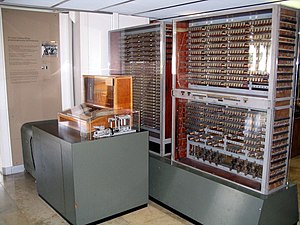Year: 2017
Turing machine
A Turing machine is a mathematical model of computation that defines an abstract machine[1]which manipulates symbols on a strip of tape according to a table of rules.[2] Despite the model’s simplicity, given any computer algorithm, a Turing machine can be constructed that is capable of simulating that algorithm’s logic.[3]
https://en.m.wikipedia.org/wiki/Turing_machine
Silence (2016)
How to Make a Bench Power Supply
http://www.instructables.com/id/DIY-Bench-Power-Supply/?amp_page=true
Z3 (computer)
Z3 (computer)
Zuse Z3 replica on display at Deutsches Museum in Munich
The Z3 was an electromechanical computer designed by Konrad Zuse. It was the world’s first working programmable, fully automatic digital computer.[1] The Z3 was built with 2,000 relays, implementing a 22-bit word length that operated at a clock frequency of about 5–10 Hz.[2]Program code[3] and constant data were stored on punched film.
The Z3 was completed in Berlin in 1941. The German Aircraft Research Institute used it to perform statistical analyses of wing flutter.[4]Zuse asked the German government for funding to replace the relays with fully electronic switches, but funding was denied during World War II since such development was deemed “not war-important”.[5]:148 The original Z3 was destroyed in 1943 during an Allied bombardment of Berlin. The Z3 was originally called V3 (Versuchsmodell 3 or Experimental Model 3) but was renamed to not be confused with Germany’s V-weapons.[6] A fully functioning replica was built in the 1960s by Zuse’s company, Zuse KG, and is on permanent display at Deutsches Museum in Munich. The Z3 was demonstrated in 1998 to be, in principle, Turing-complete.[7][8] However, because it lacked conditional branching, the Z3 only meets this definition by speculatively computing all possible outcomes of a calculation.
Thanks to this machine and its predecessors, Konrad Zuse is often regarded as the inventor of the computer.
Konrad Zuse
Konrad Zuse (German: [ˈkɔnʁat ˈtsuːzə]; 22 June 1910 – 18 December 1995) was a German civil engineer, inventor and computer pioneer. His greatest achievement was the world’s first programmable computer; the functional program-controlled Turing-complete Z3 became operational in May 1941. Thanks to this machine and its predecessors, Zuse has often been regarded as the inventor of the modern computer.
https://en.m.wikipedia.org/wiki/Konrad_Zuse
George Stibitz
George Robert Stibitz (April 30, 1904[1] – January 31, 1995) is internationally recognized as one of the fathers of the modern first digital computer. He was a Bell Labs researcher known for his work in the 1930s and 1940s on the realization of Boolean logic digital circuits using electromechanical relays as the switching element.
https://en.m.wikipedia.org/wiki/George_Stibitz
CanonCaptDrv190 – Community Help
sudo /etc/init.d/cups restart sudo lpadmin -p LBP3010 -m CNCUPSLBP3050CAPTK.ppd -v ccp://localhost:59687 -E sudo ccpdadmin -p LBP3010 -o /dev/usb/lp0 sudo update-rc.d ccpd defaults
printing – How to install canon lbp2900b printer in ubuntu 16.04 lts – Ask Ubuntu
tar -zxvf linux-capt-drv-v271-uken.tar.gz
cd linux-capt-drv-v271-uken/64-bit_Driver/Debian
sudo dpkg -i cndrvcups-common_3.21-1_amd64.deb
sudo dpkg -i cndrvcups-capt_2.71-1_amd64.deb
Source: printing – How to install canon lbp2900b printer in ubuntu 16.04 lts – Ask Ubuntu
ESP32
ESP32 is a series of low cost, low power system on a chip microcontrollers with integrated Wi-Fi & dual-mode Bluetooth. The ESP32 series employs a Tensilica Xtensa LX6 microprocessor in both dual-core and single-core variations. ESP32 is created and developed by Espressif Systems, a Shanghai-based Chinese company, and is manufactured by TSMC using their 40 nm process.[2] It is a successor to the ESP8266 microcontroller.
https://en.m.wikipedia.org/wiki/ESP32
Planimeter
Herman Hollerith
Herman Hollerith (February 29, 1860 – November 17, 1929) was an American inventor who developed an electromechanical punched card tabulator to assist in summarizing information and, later, accounting. He was the founder of the Tabulating Machine Company that was amalgamated (via stock acquisition) in 1911 with three other companies to form a fifth company, the Computing-Tabulating-Recording Company later renamed IBM. Hollerith is regarded as one of the seminal figures in the development of data processing.[2] His invention of the punched card tabulating machine marks the beginning of the era of semiautomatic data processing systems, and his concept dominated that landscape for nearly a century.
https://en.m.wikipedia.org/wiki/Herman_Hollerith
